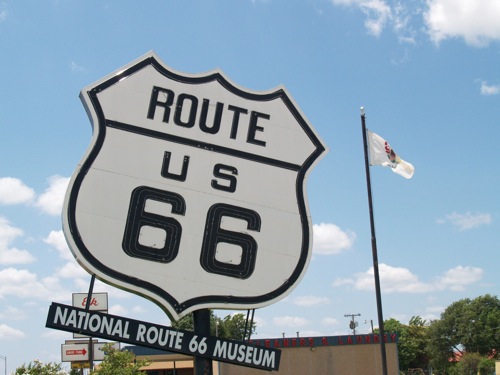
Courtesy Oklahoma Tourism
On a tour of the Grand Central region, groups can experience America’s quintessential road trip: Route 66. From Elk City, Oklahoma, northeast to St. Louis, “The Mother Road” loosely follows Interstates 40 and 44. Along the way, groups will find museums to explore, charming main streets and historic highlights. Each stop embodies the itinerant spirit of those who helped establish our nation’s highway system and held high regard for the open road.
National Route 66 and
transportation Museum
Elk City, Oklahoma
The National Route 66 and Transportation Museum are part of a four-museum complex that takes up a city block. Groups start out in the Transportation Museum, which displays a variety of 66 memorabilia: Elk City’s first fire truck, an airplane and a Popeye collection from the era. At the drive-in theater, visitors hop into the back seat of a 1959 red Impala, with drive-in speakers attached, to watch clips from old movie greats such as “The Blob.” A short film on transportation history is also shown in a replica of Elk City’s Rex Theatre.
At the 66 museum, groups follow the route’s eight states from Chicago to Los Angeles. Along the way, cars of the era, photos and murals depict the different phases of the road and interesting places that made it famous. Overhead audio kiosks recount travelers’ recorded histories and personal accounts.
The museum’s curator, Wanda Queenan, and her husband owned the Indian Trading Post on Route 66. When the interstate opened, they woke up one morning to zero traffic. It had all been diverted by the new highway. Queenan greets tours and answers questions; many consider her a walking history book.
“I talk to groups about my personal experience of owning the Indian Trading Post just west of town,” said curator Queenan. “In 2005, I was honored to be named to the 66 Hall of Fame.
www.elkcity.com
Pulaski County’s Route 66
Missouri
Pulaski County, Missouri, claims some of the nation’s best-preserved pavement resulting from Route 66’s several alignments, including the original 1926 gravel section. Local historian Terry Primas narrates a step-on tour of the road for groups. Primas wrote and produced a 65-minute DVD and authored two books about the county’s 33-mile section of the highway. Primas uses a flip book to show visitors still images of the old route.
Notable spots include Hooker’s Cut, the deepest road in Missouri, which pioneered road construction techniques. The resort town of Devil’s Elbow, on the river’s bend, was named one of the most picturesque places in Missouri in the 1930s.
The Elbow Inn and Barbeque Pit, originally known as the Munger Moss Sandwich Shop, garners international attention. Groups receive postcards that they can write and mail at Sheldon Market, a historic grocery store in Devil’s Elbow.
Waynesville’s downtown square has been revitalized. The Pulaski Courthouse Museum remains one of only two museums that sit on the historic highway. It highlights local information and Civil War military history. The Old Stagecoach Stop was built before the war and is the county’s oldest building.
“We’ve developed a Route 66 trivia game and scavenger hunt program for motorcoaches so they can keep enthusiasm high while traveling through the area,” said Beth Wiles, executive director of the Pulaski County Tourism Bureau.
Meramec Caverns
Sullivan, Missouri
Meramec Caverns, an attraction just outside of St. Louis, enjoys a long and storied history. In 1720, the Osage Indians showed French explorer Philipp Renault the cavern. During the 1890s, locals from Stanton, Missouri, held “cave parties” there during summer months to avoid the extreme heat. The cave was also reputed to have been used as a hideout by Jesse James.
Guided tours take groups along well-lighted pathways for a one-and-a-quarter-mile round trip. The Wine Room’s ancient limestone Wine Table was formed completely underwater. Only two such formations exist in the world; the other is in Sicily.
“It’s over seven feet tall and stands alone,” said vice president Les Turilli. “It’s quite unusual because most cave formations aren’t formed underwater. The water created rounded edges that resemble giant grapes.”
Other cave features include Onyx Mountain, a giant stalagmite several hundred feet in circumference. Only one similar formation in China may be bigger. The cave’s trademark Stage Curtain, created from stalactites that reach from ceiling to floor, produces an optical illusion that resembles a stage, a curtain and an orchestra pit. It’s the perfect place for a light-and-sound show.
In June, visitors can go on guided lantern tours to explore the cave, meeting historical characters along the way. An Osage Indian, a Civil War soldier and the infamous Jesse James share tales of folklore and stories of courage and adventure. A gift shop, seasonal boat rides, picnic areas a nd a candy store round out offerings.










